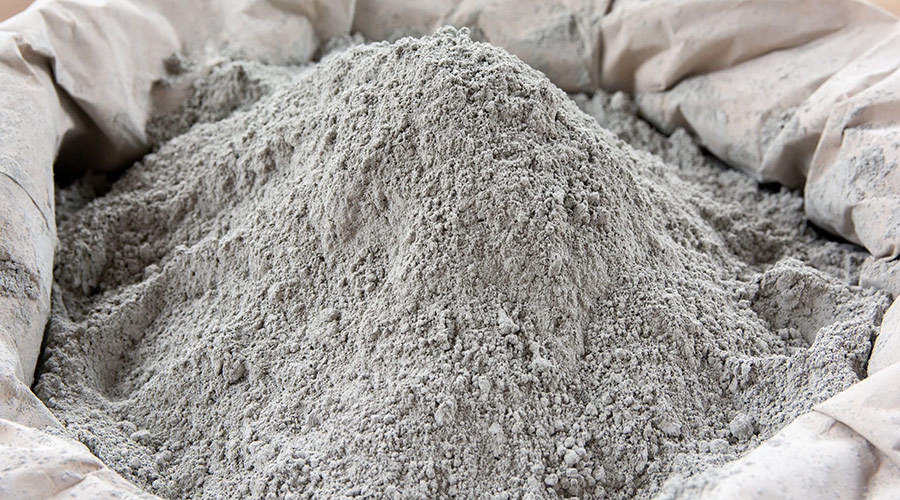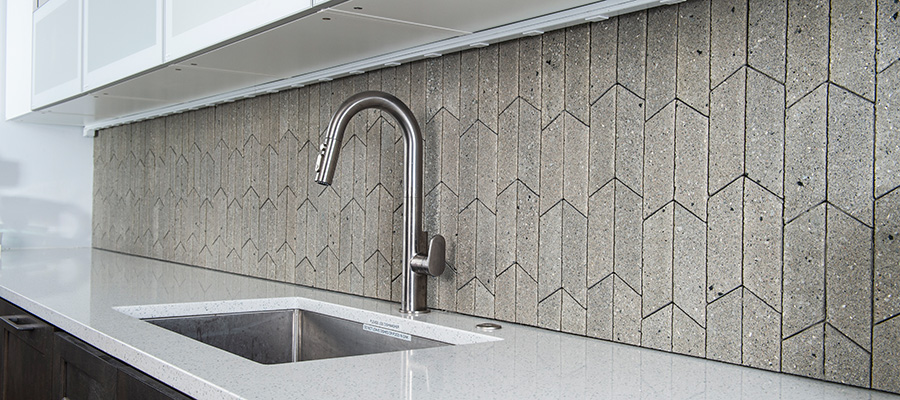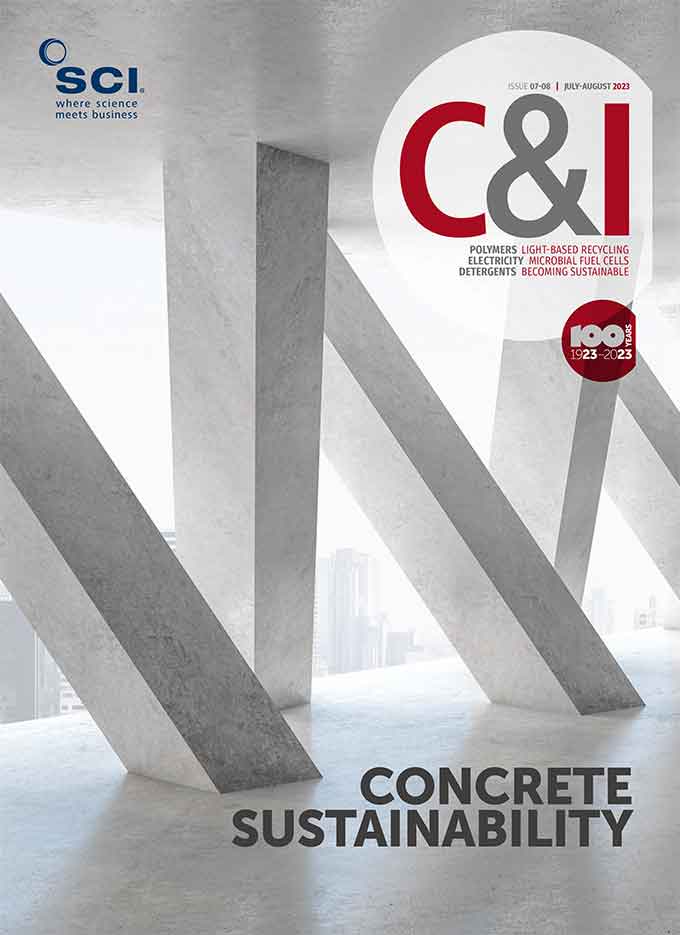Concrete is one of the world’s most consumed materials – second only to water. But production of the binding cement is a major emitter of CO2. So how can emissions be curbed? Maria Burke reports.
About 4,300mt of cement was produced in 2021, according to the International Energy Agency [1]. Meanwhile, manufacture of concrete and cement accounts for ca 7% of global CO2 emissions. About 55% of cement production is in China.
The Global Concrete and Cement Industry Association (GCCA) has committed to reach net zero by 2050. But while the GCCA’s goal is achievable, ‘the big question is the amount of reduction that needs to come from carbon capture, utilisation and storage (CCUS), which will increase the cost of production more than three times,’ says Karen Scrivener, a construction materials specialist at EPFL, the Swiss Federal Institute of Technology in Lausanne. ‘The issue is [how to balance] this expensive strategy with savings at the cement level (blended cements), concrete level (reducing cement contents) and construction level (avoiding over-design).’
Karen Scrivener gave this TED Talk on cement and concrete in 2020.
In the UK, the built environment – including construction – contributes around 40% of carbon emissions, according to a 2021 report by the National Engineering Policy Centre (NEPC)[2]. ‘The UK concrete and cement industry has delivered a 53% reduction in absolute CO2 emissions since 1990, faster than the UK economy as a whole,’ points out Dervilla Mitchell, Chair of the NEPC Net Zero working group. ‘However, more needs to be done to get on track to meet the target of achieving net zero by 2050. We know how to do this. For example, the London 2012 Olympic Delivery Authority stated its aim to reduce greenhouse gas emissions by 50%, compared with standard practice, and used its purchasing power and prestige status to develop sustainable concrete, using recycled aggregate, batched on site to reduce both transport emissions and supply risk.’
However, reducing CO2 emissions while producing enough cement to meet demand will be challenging. The CO2 emissions intensity – a measure of how much carbon is released – of cement production increased by around 1.5%/year between 2015 and 2021; whereas 3% annual declines to 2030 are necessary to get to net zero by 2050.
‘The UK concrete and cement industry has delivered a 53% reduction in absolute CO2 emissions since 1990, faster than the UK economy as a whole. However, more still needs to be done if we are to get on track to meet the ultimate target of achieving net zero by 2050.’
Dervilla Mitchell, Chair of the National Engineering Policy Centre Net Zero working group
Reducing emissions
Concrete is a mixture of water, fine aggregates (sand), coarse aggregates (gravel), chemical additives and cement. The primary component of traditional concrete is Portland cement, a calcium-silicate hydrate material manufactured from crushed limestone (calcium carbonate). Calcination requires heating limestone to temperatures greater than 800°C, resulting in calcium oxide and CO2 gas. The second stage – clinker formation – combines calcium oxide with silicates at furnace temperatures greater than 1300°C. Manufacture of 1kg of Portland cement releases ca 1kg of CO2. Half of this comes from calcination, the other half from the combustion of fossil fuels necessary to heat the kiln.
Strategies to cut carbon emissions include improving energy efficiency, switching to lower carbon fuels and promoting material efficiency to reduce the amount of clinker. Energy consumption is already starting to fall as more fuel efficient dry-process kilns replace wet-process kilns fed liquid slurry – and with the use of more efficient grinding equipment. However, fossil fuels still provide most of the energy, with bioenergy and biomass-based wastes accounting for only 4% of thermal energy used in 2021, according to IEA data.

Portland cement is ubiquitous because its constituent ingredients can be easily sourced for local production in most regions.
Using alternative fuels is a good strategy to get rid of wastes that cannot be recycled, and to reduce fossil fuels, says Scrivener. ‘However, it does not contribute much to reducing CO2 unless the wastes are of biological origin. Using biomass offers the chance to bring the highest CO2 reductions. This technology is well advanced in Europe where many factories operate at levels of alternative fuels over 90%. Due to the limitations on biomass availability, the further savings from alternative fuels are in the region 5-10%.’
The IEA is also in favour of using carbon capture to drive down emissions. Currently, around 0.1m t of cement emissions are captured but the IEA notes this needs to reach 180m t in 2030 if net zero targets are to be met. CO2 captured when making cement can be stored or used. The Leilac-2 project, for example, aims to use direct-separation CCS technology at a cement manufacturer in Hanover, Germany[3]. With €16m from the EU Horizon programme, it aims to have a plant operational later in 2023. Leilac has ‘reimagined’ calcination by separating the heat source from chemical processing of raw materials. A modular array of steel tubes indirectly heats the calcination reaction, delivering a pure stream of CO2 process emissions kept separate from any furnace exhaust gases or air. The traditional approach, involving separating CO2 from these gases, is more expensive.

Concrete is the world's most widely used building material.
Blended cements
Stepping up use of blended cements containing less clinker is another approach to improving carbon footprints. Traditional Portland cement comprises 95% clinker. But Supplementary Cementitious Materials (SCMs) – such as fly ash from coal-fired power plants or granulated blast furnace slag from iron and steel production – can reduce the clinker content.
LC3 is a new type of cement based on a blend of limestone and calcined clay developed with Swiss government funding[4]. Its developers claim LC3 cuts the amount of clinker in half and reduces CO2 emissions by up to 40%. Made using limestone and low-grade calcined clays, LC3 manufacture is reported to be cost effective and does not require capital-intensive modifications to existing cement plants.
Blended cements have a lot more potential than previously thought, Scrivener says. ‘Until recently the level of substitution was limited by the lack of availability of the classic substitutes like fly ash and slag. Now, with the introduction of the LC3 technology, limitations are more due to performance. My estimate is that we can achieve an average of 40% clinker replacement by 2030 and 60% or more by 2050. This will achieve massive CO2 reductions: 400m t/year by 2030 and 800m t/year by 2050.’
180
Currently, around 0.1m t of cement emissions are captured, but this needs to reach 180m t in 2030 if net zero targets are to be met, the IEA notes.
LC3 is a new type of cement based on a blend of limestone and calcined clay. Its developers claim that it cuts the amount of clinker used by half and reduces CO2 emissions by up to 40%.
Novel processes
California-based start-up Brimstone has another novel approach to making lower emissions cement. Instead of limestone, the company is developing a process using carbon-free calcium silicate rocks. The resulting product is chemically and physically identical to conventional Portland cement, Brimstone claims, but avoids generating carbon emissions in the calcination process. The process uses a leaching agent to pull out the calcium from the ground up rocks.
‘What sets Brimstone apart is that we are building a new process to make ordinary Portland cement carbon-negative, says Cody Finke, Co-founder and CEO of Brimstone. ‘This will be both lower cost and produce the exact same material trusted by builders for 150 years.’
Brimstone has attracted investors with its focus on creating industry-standard cement at a similar or cheaper price, instead of a more expensive alternative that might need to pass regulatory hurdles. The company plans to build a pilot plant during 2023. Another advantage is that Brimstone’s process produces two core products: Portland cement clinker and SCM. Today, clinker and SCM are produced from different processes and sourced from different locations. Brimstone says its rock contains all the minerals necessary to make both cement and SCM from one process. It also produces a magnesium-based waste product that can absorb emissions from fuel combustion.
North Carolina, US, headquartered Biomason claims it is the only company in the world employing biology to produce cement. The company’s technology uses non-modified bacteria to ‘grow’ cement materials from carbon and calcium found in recycled aggregates. The process is reported to be similar to the one that creates coral.
Biologically produced calcium carbonate forms bridges between the grains of aggregate. Whereas these bacteria typically create cemented materials over hundreds or thousands of years, Biomason’s process manages it in a matter of days and at room temperatures.
3%
The CO2 emissions intensity – a measure of how much carbon is released – of cement production increased by around 1.5%/year between 2015 and 2021; whereas 3% annual declines to 2030 are necessary to get to net zero by 2050.
Manufacture of 1kg of Portland cement releases ca 1kg of CO2. Half of this comes from the calcination stage, the other half from the combustion of fossil fuels necessary to heat the kiln.

A kitchen backsplash made from Biomason's Biolith material.
The company’s first commercial product, Biolith, comprises ca 85% natural aggregate and 15% biocement. Biolith tiles exceed the physical properties of standard materials for compressive strength, absorption, freeze-thaw, adhesion and dimensional tolerance, the company says. However, cost may well be an issue. ‘Using microrganisms to produce calcite will cost around 100 times more than current technologies, so many times more than CCUS,’ points out Scrivener.
Another way to reduce emissions is being investigated by researchers at the University of Tokyo, Japan[5]. ‘Our concept is to acquire calcium from discarded concrete, which is otherwise going to waste,’ says Ippei Maruyama. ‘We combine this with carbon dioxide from industrial exhaust or even from the air. And we do this at much lower temperatures than those used to extract calcium from limestone at present.’
His team has demonstrated a prototype reaction to create small, hardened calcium carbonate concrete (CCC) specimens. The reaction used carbonated hardened cement paste powder/silica sand and calcium bicarbonate solution made from pure CO2 gas and calcite powder.

Two samples of calcium carbonate concrete, one using hardened cement paste (left) and the other using silica sand. Both raw materials are common construction and demolition waste products. Credit: © 2021 Maruyama et al.
But it’s still early days. The team recognises there are still many challenges. Although it is a very stable material, CCC is not as strong as conventional concrete and has only been made in small blocks. As well as increasing the strength and overcoming the size limitations, the researchers would like to further reduce process energy consumption. But Maruyama is hopeful that in coming decades, carbon-neutral CCC will become the mainstream type of concrete.
Researchers at Worcester Polytechnic Institute in Massachusetts, US, have yet another approach. Their Enzymatic Construction Material (ECM)[6] is made using trace amounts of carbonic anhydrase, an enzyme derived from biological cells, to catalyse the condensation of CO2 and water, and promote precipitation of calcium carbonate crystals when sand and gelatin are added. The gelatin polymer provides a scaffolding framework that initiates crystallisation and establishes strong crystal bridges connecting the sand particles.
‘Carbonic anhydrase has the unique ability to rapidly remove the greenhouse gas CO2 from the atmosphere,’ says Suzanne Scarlata, who is leading the research with colleague Nima Rahbar. ‘This property has allowed us to formulate a carbon-negative material that we hope may ultimately replace concrete.’
The researchers found that ECM has ‘outstanding’ compression strength, making it suitable for construction. It also does not require baking at high temperatures and can be made quickly – unlike the 28 days needed to cure concrete – and at a low cost. With their start-up company Enzymatic, the team hopes to bring the material out of the lab. The company is focused on optimising enzyme efficiency, the properties of the scaffolds and the mechanics of crystal structure.
There are ‘no miracle solutions,’ Scrivener believes, ‘But there are a lot of steps we can take, which, if integrated together, can led to reductions of CO2 possibly up to 80% before the need for CCUS.’
References
1 IEA - Cement, 2022
2 Decarbonising construction: building a new net zero industry
3 Leilac
4 Limehouse Calcined Clay Cement - LC3
5 I. Maruyama et al, J. Adv. Concrete Tech., 2021, 19, 1052
6 S. Wang et al, Matter, 2022, 5, 957





